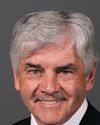Thank you very much, Chairman and colleagues.
Mr. Chairman, honourable colleagues, my officials and I appreciate this opportunity to come to this committee to provide information on Building Canada, the Government of Canada's infrastructure plan.
As the members of this committee know, on November 6, the Prime Minister launched the $33 billion Building Canada infrastructure plan. This plan is the most comprehensive of its kind in Canada's history. It provides stable and predictable funding for the longest period of time ever committed to by any federal government over the past 50 years.
This plan is strategic, comprehensive, and responsive to the needs of provinces, territories, and the municipal sector.
Specifically, this plan includes $17.6 billion in base funding for municipalities until 2014, including a full goods and services tax rebate, and $11.8 billion through the gas tax fund. Per year, it provides $25 million, over seven years, in base funding to provide provinces and territories an additional $175 million for each jurisdiction. It provides $8.8 billion for the new Building Canada fund, which will be applied to major projects as well as projects in smaller communities with less than 100,000 in population. As well, $2.1 billion will be provided for the new gateways and border crossings fund to improve the flow of goods between Canada and the world; $1.25 billion for the new national fund for public-private partnerships; and $1 billion for the Asia-Pacific gateway and corridor initiative.
Building Canada will target five national priorities: safe drinking water, efficient sewage treatment, efficient public transit, safe roads, and green energy. For example, this plan will support a growing economy by providing funding for borders and gateways, for short-line rails, broadband, and regional and local airports.
And, Mr. Chairman and honourable colleagues, the plan will support stronger and more cohesive communities by investing in roads and bridges as well as regionally significant sport and cultural infrastructure. These are all areas that matter to provinces, territories and municipalities. Indeed, these are areas that matter to Canadians.
When we first came into office in 2006, we began extensive consultations with provinces, territories and the municipal sector. Our plan reflects what we heard that summer.
We've come a long way since those consultations. We now have a plan and our money is on the table. In order to get that money flowing to municipalities, provinces, and territories, they need to step up to the plate and sign framework agreements with us under the Building Canada plan.
Already we've signed agreements with British Columbia, Nova Scotia, and New Brunswick. These agreements lay the foundation for cooperation, for collaborative relationships between Canada and the provinces and territories, so that we can collectively manage public infrastructure priorities and issues. We look forward to signing more agreements with other provinces and territories in the near future.
Now, in the meantime, this government has already moved forward and made clear commitments to particular projects across the country. For example, as part of the framework agreement with British Columbia, we announced a commitment of up to $64.2 million towards additional improvements of the Trans-Canada Highway through the Kicking Horse Pass canyon.
For example, this government, together with the Government of Quebec, announced a commitment of up to $13 million to the Montreal Museum of Fine Arts and another commitment of up to $40 million to the Quartier des spectacles.
Also, together with the Government of Alberta, we announced a commitment of up to $15 million to the Kinnear Centre for Creativity and Innovation at the Banff Centre, as well as up to $40 million for the Centre of Sports Excellence in Calgary.
Also, in March of this year, the Prime Minister announced close to $1 billion for FLOW, a transportation action plan for the greater Toronto area. FLOW involves concrete projects designed to reduce traffic congestion, improve the environment, and increase economic growth in one of the fastest-growing areas in the country.
In addition, in March 2006, the Prime Minister announced our commitments to the clean-up of Saint John Harbour and to highways across the province of New Brunswick. As you can see, we've already started taking action and we are moving forward.
As my honourable colleagues know, the federal government alone cannot address all the issues and needs related to infrastructure in this country. Although, in reading the papers these days, one would think this should be the case.
Our approach in developing Building Canada highlights the extent of federal involvement and confirms our respect for jurisdiction, as well as our commitment to working collaboratively on issues.
That means that we all must—the Government of Canada, provinces, territories, municipal sector, and industry—work together to meet this country's infrastructure challenge. I'm pleased to report that we've already started the work cooperatively and collaboratively.
For example, we're working with the provinces and other key stakeholders to develop strategies to take advantage of Canada's international gateways and trade corridors. While the Asia–Pacific gateway and corridor initiative was first, we now have signed two memorandums of understanding—one with Ontario and one with Quebec—and another one with the Atlantic provinces. These MOUs must provide analytical frameworks for the development of continental and Atlantic gateway strategies that will help us meet the challenges of globalization and support Canada's economic prosperity and global competitiveness.
These collaborative initiatives, in addition to the framework agreements, are clear examples of partnership and collaboration, and I'm sure you will see more of this type of cooperation as time goes by.
But we must also recognize that governments alone cannot meet the demand. We need to consider alternative funding for our infrastructure. Private capital and expertise can help bridge the gaps and make a significant contribution to building infrastructure.
As a result, the use of public-private partnerships—or P3s as they've come to be known—has been expanding rapidly around the world. Canada has made some progress in the use of P3s with the development of some high-profile projects, but more needs to be done. That is why this government is taking a leadership role in developing P3 opportunities through its $1.25 billion Public-Private Partnerships Fund as part of the Building Canada plan.
The government is also working on the creation of a new public-private partnership office that will facilitate a broader use of P3s in infrastructure projects. As well, we are encouraging the development and use of P3s' best practices by requiring that all projects seeking $50 million or more in federal contribution under the Building Canada plan and Building Canada fund, or the gateways and infrastructure crossing fund, consider whether P3s are a possibility and whether they're feasible. I'm currently working with my colleague, the Minister of Finance, on the development of the P3 office and P3 fund. So stay tuned for more news on that front.
The public infrastructure challenges facing Canada are significant. Through the long-term and predictable funding commitment under the Building Canada plan, the federal government has taken steps to address these challenges and ensure that our economy is stronger, our environment is cleaner, our country is prepared for current and future growth, and we can compete internationally.
Our plan is strong and our commitment to public infrastructure and to municipalities is clear. Over half of the $33 billion in funding available is aimed directly at municipalities. That's a minimum of $17.6 billion over seven years, in predictable funding plus a significant support through the targeted funds. In my books, that's a lot of money. This plan is innovative. It provides predictable funding over a longer period than that proposed by any previous federal government.
While there are no easy answers or quick fixes, I think it's clear that broad-based cooperation that is based on a plan is the best way to improve infrastructure and to ensure that citizens live in strong and safe and prosperous communities that we'll aspire to build together.
Thank you, Chair. Thank you, colleagues.



